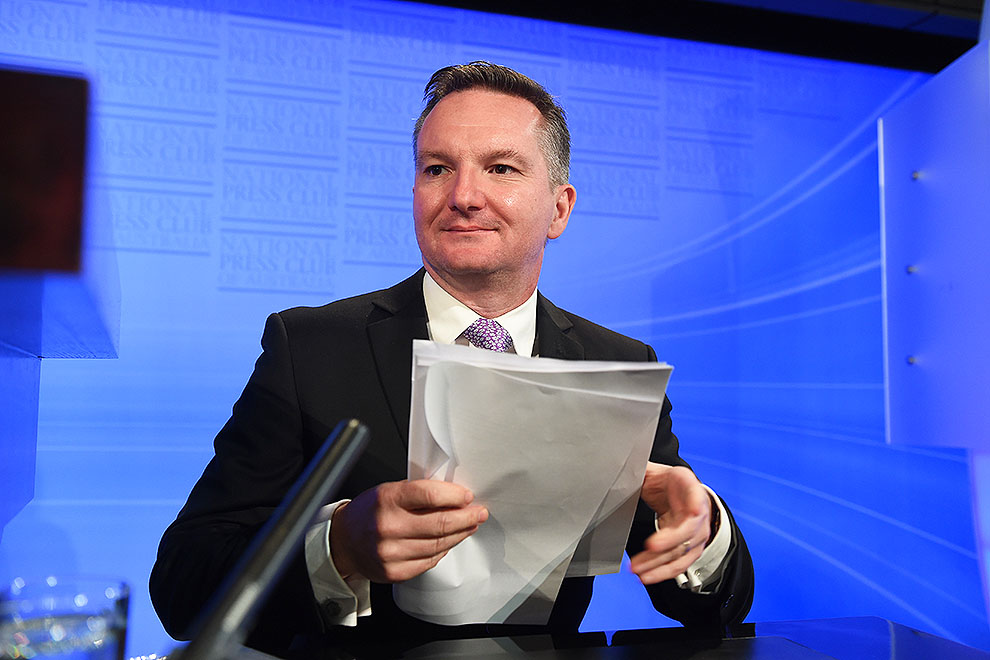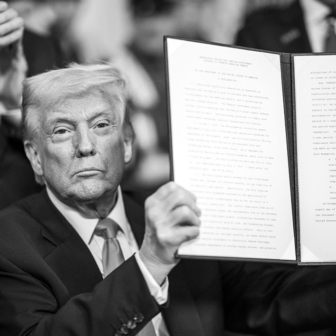The Turnbull government was courageous indeed to put a big company tax cut at the centre of its economic policy. And shadow treasurer Chris Bowen was equally courageous this week in pledging that Labor would maintain Australia’s AAA credit rating, come what may.
It was brave, first, because anything Labor says on debt allows the Coalition and its media allies to revive the image of “debt and deficits,” which they have successfully defined in the minds of many voters as the legacy of the last Labor government. Bowen knows that, but he decided that the best way to counter the image was to tackle it head on.
It was also brave because it came in the wake of two alarming reports from the ratings agencies that received surprisingly little media coverage, apart from two thoughtful pieces by the Australian’s economics editor David Uren. Both ratings agencies imply that the risk of Australia losing its AAA credit rating has moved from what was once merely a hypothetical possibility to a real one.
In the first, Moody’s expressed clear disappointment that the budget had yet again ignored the need to reduce the deficit. It warned that the persistent failure to do so has left Australia’s public finances “vulnerable to negative shocks, particularly to a potential marked downturn in the housing sector, and a reversal in current favourable external financing conditions.”
Moody’s noted the budget forecast that the deficit would close by 2020–21, but pointed out that each budget since 2010 has made similar forecasts, all of which have proved wrong. It judges the latest budget to be similarly over-optimistic. The agency had already criticised the government for ruling out revenue hikes to get back in the black. This time it highlighted the successive failures to cut spending, and pointed out the political constraints in the way.
Large spending commitments on education, health, and social security and welfare will make it challenging to achieve the necessary cuts to balance government finances. These three areas will account for around 60 per cent of total spending in FY2017.
Over the last five years, expenditure in these three areas has increased by 21.3 per cent, compared to 19.5 per cent for other spending… The government budgets [for] a rise in social services spending by $124.5 billion in real, inflation-adjusted terms by FY2020, while most other spending functions will see a moderate contraction. Defence spending is also slated for a marked increase, by 6.4 per cent in real terms by FY2020.
The message is clear: get real. You can’t rely on spending cuts alone to get back in the black. And if the government doesn’t get back in the black, then it will be vulnerable to a surge in the deficit – and the loss of its AAA rating – if something goes seriously wrong. The bursting of the real estate bubble is possible one shock, another is panic on global financial markets, and another (not mentioned by Moody’s) is the collapse of the mountains of debt underpinning China’s economy.
This last risk is the subject of the second report, by Standard & Poor’s, a firm that curiously has yet to make any comment on the federal budget (in a sharp break from its usual practice). Whatever that implies, it is not support for the budget strategy.
The S&P report concluded that if China hits serious trouble then Australia would be one of the countries worst affected. In its hypothetical scenario, GDP growth would shrink to just 1.2 per cent a year over the first three years, implying falling living standards and rising unemployment – and the federal government, the banks, resource companies and a couple of state governments would all have their credit ratings downgraded.
An important caveat: S&P made it clear it was not predicting that China would hit the wall. Rather, its purpose was to carry out a “stress test” on the potential impact on the world economy if China’s official growth rate halved to average just 3.4 per cent over the next four years. (Many observers believe the real growth rate has already fallen part of the way to that level, although Chinese authorities will not admit it.)
Of the ten largest Western economies, only Korea and Japan, both big investors in China, would face more economic damage than Australia if the world’s biggest economy went into a slump. And with China trying to fire up its economy by adding still more debt to the fire – and in China, being able to borrow means that you have political influence, not necessarily that you are judged able to repay the loan – many analysts believe its government is only increasing the likelihood that the stimulus will end in a hard landing.
This was the background to Bowen’s speech to the National Press Club on Tuesday, an impressive performance during which he squarely addressed some of the issues of Australia’s debt and deficit binge, and made two key promises to voters. First, a Labor government would not allow Australia to lose its AAA credit rating. Second, it would bring forward the Mid-Year Economic and Financial Outlook, or MYEFO, from December to early October to allow it to update the forecasts, factor in Labor’s policies and take charge early if budget changes are needed.
We’ll come back to that second point. The federal government’s AAA rating matters. It underpins all other credit ratings in the country, including those of the banks and the big resource, retail, transport and other firms that borrow directly from global markets. If they have to pay more interest on their debt, so will we. And Australia is now carrying an awful lot of debt.
Our net foreign debt is now more than $1 trillion; in the past decade, it has more than doubled, and in the past twenty years, it has grown fivefold. It now stands at a record 62 per cent of GDP. Back in the late 1980s, when it hit 30 per cent of GDP, everyone was talking about it and it was used to justify deep spending cuts. Now it is twice that level, yet we have grown so complacent that, as David Uren noted, the Reserve Bank last week failed to even mention it in its sixty-six-page Statement on Monetary Policy.
The ratings agencies have noticed it. During the boom, the underlying growth in debt – borrowed mainly by resource companies and the federal government – was disguised by the rising dollar, which made it look smaller in Australian dollars. Now, as our dollar has fallen, the foreign debt has surged. When interest rates eventually head back towards normal levels, the cost of servicing it will surge too.
Back home, our housing debts now total almost $1.5 trillion. That is five times as much as we owed fifteen years ago. The Bureau of Statistics estimates that total household liabilities have doubled in a decade to $2.2 trillion, but our incomes have not kept pace. Household debt by the end of last year was 1.86 times household income. Forty years ago, our debts amounted to just a third of our income. The burden of that debt places serious constraints on household spending in other areas.
Then there is government debt. The federal government’s financial position has gone from net assets of $45 billion when Labor took office to net debt of $153 billion when it left. Since then the debt has almost doubled to an estimated $286 billion by the end of June; on optimistic assumptions, it will reach $356 billion before it peaks.
Australia’s economy has performed better than most of its counterparts over the past twenty to twenty-five years, and we are constantly told that this is due to the economic reforms we carried out in the 1980s and 90s. There is some truth to that, but it ignores an equally large reason why we grew faster than most in our peer group: we borrowed mountains of money from the rest of the world, and went out spending it.
Australia has not run a current account surplus since 1973. We have settled into a pattern of living beyond our means, and borrowing from the rest of the world to close the gap. In day-to-day life, this never matters until the day it really matters – when markets decide we have become too big a risk to lend money to unless we pay a hefty premium.
The AAA rating is meant to assure lenders that lending to us is as safe an investment as they can make. And given that no one has ever lost money by lending to an Australian government, in the real world it still is. You can’t imagine an Australian government defaulting on a debt payment.
But the global ratings business depends on agencies making fine distinctions between levels of risk. Australia is one of few countries to enjoy AAA ratings from all three agencies (Moody’s, Standard & Poor’s and Fitch). In his National Press Club speech, Bowen claimed that this gave us a discount of about 0.25 per cent on our borrowings, compared to a mere AA rating.
Losing the AAA rating, he said, would increase the government’s borrowing costs by about $900 million a year. “As a progressive alternative treasurer who wants to fund investments in schools, hospitals and infrastructure, I want to have that money available, not being wasted on payments to bond holders.”
Moreover, the higher interest rates the Commonwealth paid would flow on to the rates paid by state governments, major corporate borrowers and the banks. And while Bowen didn’t say it, the banks would almost certainly pass on their increased borrowing costs to all who borrow from them: us.
These flow-on effects, Bowen said, would add billions of dollars a year to the interest bills facing business (not to mention households). He is right, and it means the federal government is in a very different position from the states on this issue.
State governments could lose their AAA credit ratings with no consequences for other borrowers. I am one of the growing number who argue that New South Wales and Victoria should be willing to do so, to free them to tackle the mounting infrastructure needs of Sydney and Melbourne in the cheapest way possible – by government debt. Taking on debt for viable projects to build better roads and rail delivers social and economic returns that outweigh the extra borrowing costs. It is quite different from a government borrowing because it is afraid to raise taxes to meet its everyday bills.
Bowen also thumped home his message with a warning that was doubtless intended to define him as a no-nonsense, hard-headed treasurer who could make tough decisions. “The best strategy on the AAA rating is: don’t lose it. Keeping it is easier than getting it back,” he said. “If it means dropping ideological leanings and reducing the deficit through both spending and revenue decisions, you do it.”
He went on: “As Moody’s has made clear, the AAA rating is under real pressure. Regardless of which of us receives the incoming treasurer’s briefing on Sunday July 3, whether it is Scott Morrison or me, the treasurer will have to deal with the pressure. An incoming Labor government won’t have time to waste.”
Within ninety days, Treasury and Finance would be expected to bring out an early mid-year economic and fiscal update, with “realistic” forecasts to allow Labor to “put our stamp on the economic agenda early in the term.” Bowen insisted that this would not be “an alibi for breaking [our] promises” but “a vehicle for implementing” them. But his oblique reference to potential spending cuts suggests that a new, “realistic” stocktake might prescribe unpleasant medicine.
His pledge to maintain the AAA rating is a brave one, because circumstances might overwhelm anything a future government could do if things go seriously wrong. If Labor wins, it is a promise that will not be forgotten.
No one on the Coalition side is talking about the risks ahead, but it is widely expected that if it is re-elected it will toughen its budget stance at the first opportunity. The mildness (and, in some areas, generosity) of this budget is at odds with the reality that we are heading into our ninth year of large budget deficits, and we need to set out a credible path to ending them. That will require higher revenues, because, as Moody’s implied, you can’t get there by spending cuts alone.
But that would require either Malcolm Turnbull or Bill Shorten to lead a serious conversation with the Australian people. No one should expect that in the next seven weeks. We don’t like those conversations, and they have an election to win first. •




